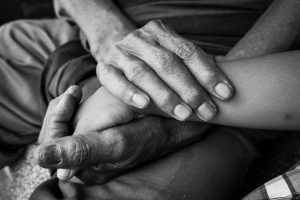Prep for the Session
Overview
This resource explores Service Activity through the value of Compassion.
At-a-Glance:
This resource engages with different feelings of guilt that participants might feel in their service activity, and how the value of compassion sheds light on them. The resource is designed to be facilitated in sections, with a break in between for the service activity. Prior to the service activity, a question will be posed to learners to consider during their service. After service, they will have an opportunity for reflection and processing.


- To be paired with a service activity component.
- For young adult and adult learners.
Let’s Get Started
FRAME THE ISSUE

Facilitator reads the following for context:
Before, during, and after a service project, participants often feel guilt: Guilt about our own wealth or privilege, guilt that what we are doing doesn’t have enough impact, guilt that we could be doing more but are not. Left unaddressed, guilt can paralyze us. In and of itself, guilt is not a bad thing; it is a signal, a data point. The challenge is in how we respond to guilt and what we do with it. Today we’re going to explore the value of compassion in how we apply it both to others and to ourselves.

Facilitator prompts the group:
- What brought you to the service work you are doing today?
- Note for yourselves any feelings of guilt you might have right now. (There is no need to share this, just name and hold the feelings for yourself.)
- What approaches do you already have for dealing with your guilty feelings?
EXPLORE THE VALUE

Facilitator prompts:
The two photos below are ones that appear in a google search of images with the keyword “compassion.”


Facilitator prompts the group:
- What title would you give to each photo that connotes compassion?
Facilitator continues reading:
Let’s connect the value of compassion to the feelings of guilt raised above. We might be tempted to address guilt through a value such as Responsibility or Justice, something that calls us to meet a higher standard and be, give, or do more. Psychologically, however, that is more likely to set us up for failure, when we fall short of our aspirations, which then breeds more guilt. Compassion can provide amore productive lens.
We usually think of compassion as awareness of and tending to the suffering of others, but we also deserve compassion from and for ourselves; this can soften our self-judgmental habits. After all, all people deserve compassion. If we can read our guilt signals with compassion, we can interpret them in a more clear-headed way and take more productive steps to act on them.

Facilitator prompts the group:
- When you think about compassion, what comes to mind? How does your body feel?
- When was a time when you exercised compassion for yourself? How did that then translate into your relationship with others?
JEWISH ANCHOR

Facilitator reads or, depending on context, has group members read in havruta/pairs and respond to the prompts below:
The following is from Rabbi Dorothy Richman, for AJWS, from My Jewish Learning, describing the rationale behind the asham-guilt offering sacrifice described in the Torah. (While animal sacrifices might feel like a foreign practice in our modern world, the rationale behind them can illuminate.)
In [Leviticus 7:2-10], guilt feelings are transformed into actions bringing healing. The ritual of the guilt offering, asham, is straightforward… Offering this sacrifice, a person’s guilt is made publicly manifest and is then absolved…
Amorphous feelings of guilt were brought out of one’s internal world and were transformed into concrete objects in a shared communal experience. While our modern sense of guilt connotes angst, “shoulds” that stay inside of us to no good purpose, the ancient guilt offering went out and away… and nourished the priests… The model of the ancient asham encourages us to transform those interior feelings into communal acts of love and justice. Isolated, we see our inadequacy and shame. Getting closer to one another, in community action and advocacy, we approach healing.

Prompt/thought questions:
- How does this ritual work, practically and/or psychologically, according to Rabbi Richman’s interpretation? Does that work for you? Why or why not?
- What gets in the way of being compassionate towards others?
- What gets in the way of being compassionate toward yourself?
- How does the release of guilt affect your ability to be compassionate?
*PROMPT BEFORE SERVICE*
Facilitator prompts the group:
- As we prepare to move into service, think again about what motivated you to be here today. See if you can get it down to just one word or a short phrase.
- Once you have your word or phrase, zoom out one level in your brain to reflect on that word. How do you feel about that as a motivation for being here today? (Some possibilities: heavy, energized, driven, disappointed, excited, judgmental, committed…)
*BREAK FOR SERVICE EXPERIENCE*

Prompt action

Facilitator prompts the group:
- With a havruta/partner, return to and review the questions posed before the service activity.
- Now, choose one of the following:
-Try to encapsulate or condense your experience today–the service, the text, the discussion– into a single short phrase, like a mantra, that you can use as an antidote for guilt.
OR
-Try to encapsulate or condense your experience today–the service, the text, the discussion– into a single short phrase, like a mantra, that you can use to expand your compassion.
- Spend two minutes coming up with your mantra/phrase.
Facilitator goes around in a circle and has each participant share their mantra/phrase (just the phrase, without elaboration.)

Close with intention

Read the passage below:
Guilt is a normal feeling that provides us with information about things that are true in the world: It is not fair that some people have comfortable lives while others suffer, and we could always be doing more to help. Rather than allowing that guilt to paralyze us or throw us into a tailspin of despair, we can use the value of Compassion to help us open our hearts. Compassion can invite us forward into “communal acts of love and justice,” allowing us to make decisions on a basis of both guilt and love.
Facilitator prompts the group:
- What is one “communal act of love and justice,” flowing from your deepened understanding of compassion, that you want to commit to in the coming month?





 Back to What do I do with my guilt?
Back to What do I do with my guilt?